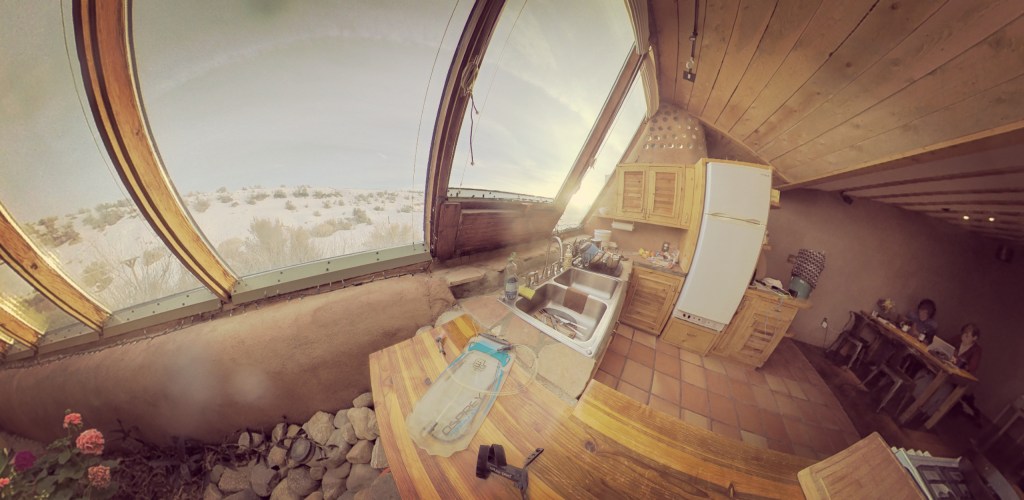On the recommendation of Joanna’s former housemate Dave, we decided to stay in an Earthship AirBnB for our three days in Taos, New Mexico in January.

Earthships are basically a brand of zero-energy buildings, and there’s a large condo development of them on an old quarry site (so as not to further disturb the land) about 25 minutes outside of Taos, just past the beautiful Rio Grande gorge.
The trip brought Joanna back to all of her memories of learning about passive houses (another word for the same concept) during college. Lots of thermal mass and insulation, windows that let light inside yet block heat loss to the outside, solar panels, direct current appliances that can make more efficient use of solar energy, rainwater capture, water recycling/reuse, and much more.
In theory, an Earthship is self-sufficient, with naturally occurring sunlight, wind, water, earth, and nearby wood providing everything necessary for all heating, cooling, food/drink, waste processing, and other needs. We both found it inspiring and delightful, and appreciated the sense of connection with the world around us. Morning rituals of opening the blinds to let in the light, delighting in the quickly warming clay tiles underfoot, and only showering once it’s warm enough. Evening rituals of closing the blinds at sunset to keep the heat in, stepping outside to admire the milky way, staying warm by cooking together, and using the wood stove if it’s especially cold. Tending to the house took a little time, but not too much. It felt good; it felt grounding. And it was neat to see how obviously the Earthships were inspired by the local Pueblo Indians’ architecture, with its thick adobe walls.
Here’s a short walk we took inside (you can pan to look around):
At the same time, things about the Earthship also felt impractical (Bryan) and/or outdated (Joanna), and not actually as green as they seem. Tourists like us can’t get by on so little water (Taos gets 7 inches per year), so they truck it in. There’s propane to heat all that water, propane for cooking, and it looked like the fridge was operating in propane mode, too. The whole development is a 25 minute drive from town, and while it’s possible to build a multifamily Earthship, their density is very limited. Among other things, Joanna was confused as to why they use solar water heating instead of electric (solar water heating is theoretically elegant but not as economical), why the cooking isn’t electric, why the blinds aren’t insulated (and automated), and why they’re doing rather outdated things like DC circuits (since conversion from AC to DC has been nearly lossless for many years now).
In areas where infrastructure exists for growing food, treating wastewater, generating power, we question whether it is more efficient to centralize versus build self-contained homes; however, in parts of the world where such services don’t exist or aren’t reliable, an Earthship has benefits.
By promoting Earthships as an ideal, are their builders encouraging visitors to thoughtfully consider their resource use and find ways to live more in harmony with the planet? Or are they showcasing outdated and non-scalable technologies and land use patterns that are not really the most comfortable, efficient, or effective ways to solve our problems – and thereby furthering the idea that environmental sustainability is inconvenient, impractical, for tree huggers only, and not yet ready for prime time? Even after staying there for several days and deeply enjoying it, we’re not quite sure.
Leave a comment